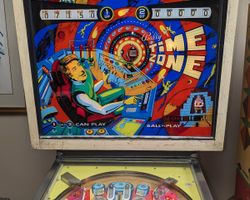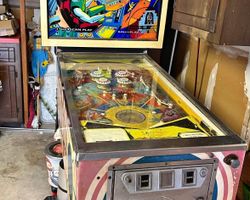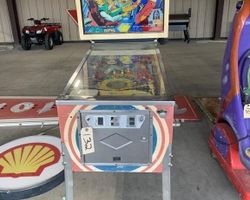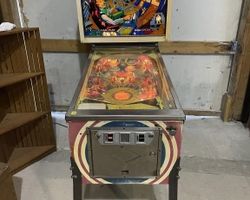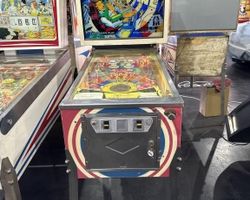Time Zone

Average Prices: USD $200 to $1,000
Produced: May, 1973
Production Run: 2,500 units
Machine Type: Electro-mechanical
Players: 2
Design by: Jim Patla, Ted Zale
Art by: Christian Marche
Bally Manufacturing Corporation introduced "Time Zone" in May 1973, an electro-mechanical (EM) pinball machine that offered a unique take on the popular science fiction theme of time travel. The game, bearing the model number 939, emerged from Bally's extensive development pipeline, which had already established the company as a prominent force in the arcade industry. "Time Zone" was designed by Jim Patla, a designer known for his thoughtful playfield layouts, while the distinctive artwork was created by Christian Marche, whose contributions frequently brought a vibrant aesthetic to pinball machines of the era. With a production run of 2,500 units, "Time Zone" arrived in arcades and pinball halls, aiming to captivate players with its imaginative premise and engaging features. Notably, "Time Zone" was the two-player version of Bally's earlier four-player title, "Space Time," released in 1972, sharing a fundamental design but adapting it for a different player count. This lineage underscored Bally's efficiency in adapting successful concepts while refining them for specific market segments.
Signature Features and Design
"Time Zone" distinguishes itself with several notable design elements, but none more central than its "Time Tunnel." Positioned in the lower playfield, this three-dimensional representation of a tunnel is adorned with flashing lights that sequence downwards, creating a visual effect that directly evokes the sensation of traveling through time or space. This feature serves as more than just a visual spectacle; it is an integrated scoring mechanism, cycling through point values from 1,000 to 5,000 as the lights progress. The Time Tunnel operates via an under-playfield mechanism, a testament to Bally’s engineering ingenuity in creating dynamic interactive elements within an EM design.
Beyond this central innovation, the machine’s overall aesthetic is defined by Christian Marche's artwork. Both the backglass and playfield are adorned with vibrant colors and stylized depictions that fully embrace the science fiction theme. The artwork is characterized by its creative use of imagery, depicting various cosmic phenomena and temporal distortions that complement the game's theme. The backglass, in particular, has received recognition for its detailed and visually appealing composition, often cited as a superior representation of the theme compared to its four-player counterpart. The combined effect of the Time Tunnel's lighting and Marche's detailed artwork immerses players in the journey through different temporal dimensions.
Playfield and Mechanics
The playfield layout of "Time Zone" balances open space with strategic targets, encouraging both fast-paced action and calculated shots. At its core, the machine features two flippers positioned traditionally at the bottom, providing the primary means of ball control. Dominating the upper-middle section of the playfield are four powerful pop bumpers. These bumpers are key to the machine's energetic gameplay, propelling the ball with force and generating high-scoring chaos as it ricochets off them. Flanking the lower playfield are two slingshots, which contribute to the ball's kinetic movement.
Scattered across the playfield are five standup targets, offering distinct objectives for players to aim for. The layout includes two kick-out holes, which provide additional scoring opportunities and alter the ball's trajectory, often returning it to the playfield in unexpected ways. A left kicker lane and both upper and lower gates further add to the playfield’s complexity, guiding the ball into specific scoring areas or creating opportunities for a replunge. A unique defensive feature is the up-post located between the flippers. This post can activate to prevent a center drain, acting as a ball saver or a target for a skillful shot to keep the ball in play.
However, a central block of three targets in the middle of the playfield presents a point of design consideration. While offering additional points, some players perceive these targets as potentially obstructive, occasionally hindering access to the upper playfield or creating high-risk shots that can lead to quick drains. Despite this, the overall design philosophy prioritizes a lively, engaging experience. The Time Tunnel's integration into the lower playfield ensures that shots directed downwards still contribute significantly to scoring and visual spectacle. The lighting scheme throughout the playfield, particularly the sequencing lights on the Time Tunnel, enhances the thematic immersion, transforming the game into a dynamic visual experience.
Gameplay Dynamics
Gameplay in "Time Zone" is driven by a straightforward yet compelling scoring system, typical of electro-mechanical machines of its era, with a maximum displayed point score of 99,990 points per player. The central Time Tunnel is not only a visual anchor but also a strategic target. Players can use the manual plunger to execute a skill shot, aiming to stop the tunnel's cycling lights on the highest point value (5,000 points) as the ball enters the feature, adding an immediate layer of challenge.
The four pop bumpers are crucial for accumulating points and maintaining ball movement. Shots into this area often lead to unpredictable, fast-paced sequences, as the ball is rapidly deflected, contributing to scores and keeping players on alert. The game features two kick-out holes that, once triggered, eject the ball back into play, often with a unique trajectory that requires quick player reaction. The upper and lower gates allow the ball to be directed into specific lanes, sometimes offering special scoring bonuses or the chance for a replunge, effectively extending the ball’s duration.
While "Time Zone" does not feature complex multi-stage modes or deep narrative objectives, its design focuses on immediate gratification and the satisfaction of hitting various targets. The pop-up post between the flippers serves as a valuable defensive mechanism, preventing center drains and allowing players to recover from what might otherwise be a lost ball. This post can also be targeted intentionally for additional points. The chimes, integral to the soundscape of EM machines, provide auditory feedback for scoring events and contribute to the machine's classic feel, though some players have noted their sound quality to be less refined than other Bally titles. The game's progression revolves around accumulating points to earn replays, with a replay wheel maximum of 25. The challenge lies in mastering the plunger skill shot, controlling the chaos of the pop bumpers, and strategically aiming for the various targets and kick-out holes to maximize scores and extend gameplay.
Reception and Legacy
"Time Zone" has generally been received positively within the pinball community, particularly by enthusiasts of electro-mechanical machines. Its strengths are frequently highlighted, with the innovative "Time Tunnel" feature consistently cited as a standout. This under-playfield mechanism, with its flashing lights and cycling scores, was a novel inclusion for its time, providing a visual spectacle and a unique scoring opportunity that elevated the machine beyond many of its contemporaries. The artwork by Christian Marche is also a significant point of praise, described as vibrant, creative, and a key factor in the machine’s thematic appeal. The four powerful pop bumpers contribute to a fast-paced and energetic game, creating a sense of action and excitement. Additionally, the pop-up ball saver post between the flippers is appreciated as a valuable defensive mechanism.
However, "Time Zone" also has its acknowledged limitations. The flippers are sometimes described as having a weak or "mushy" feel, lacking the crisp response found in other machines. This can make precise shot-making challenging for some players. The ruleset, characteristic of many EM games, is not deep, leading to gameplay that can sometimes feel random or lacking clear, overarching objectives. While fun, the progression might rely more on "happy accidents" than deliberate strategic planning. The central block of three targets on the playfield has been a point of mixed feedback; some players find them to be an obstructive element that can interfere with the flow of the ball or present high-risk shot opportunities. Furthermore, the quality of the chimes has been noted by some as being somewhat uninspired compared to other Bally releases.
Despite these criticisms, "Time Zone" holds a respectable position in pinball history. Its legacy is largely defined by its unique Time Tunnel feature, which showcased Bally's commitment to integrating innovative visual and mechanical elements into its EM designs. It is often regarded as a fun and engaging machine, particularly for casual play or for those seeking a change of pace from more complex solid-state games. Its strong visual presentation and engaging, if straightforward, gameplay ensure its place as a memorable and sought-after piece for collectors and enthusiasts of early 1970s pinball. The machine stands as an example of an EM that pushed the boundaries of playfield features, demonstrating how creativity could still thrive within the constraints of electro-mechanical technology.
Sponsored Links
 Ebay Listings
Ebay Listings
 Auction Results
Auction Results
| Cost | Location | Date |
|---|---|---|
| USD $1,350 |  United States United States |
17 October, 2025 |
| USD $1,199 |  United States United States |
14 October, 2025 |
| GBP £2,699 |  Portsmouth, United Kingdom Portsmouth, United Kingdom |
15 November, 2024 |
| USD $375 |  Missouri, United States Missouri, United States |
05 October, 2024 |
| AUD $1,300 |  New South Wales, Australia New South Wales, Australia |
10 December, 2023 |
| USD $600 |  Maryland, United States Maryland, United States |
06 August, 2023 |
| USD $1,000 |  California, United States California, United States |
15 January, 2023 |
| USD $375 |  Oklahoma, United States Oklahoma, United States |
13 October, 2022 |
| USD $1,290 |  Tennessee, United States Tennessee, United States |
27 April, 2022 |
| USD $1,500 |  Missouri, United States Missouri, United States |
14 October, 2021 |


Private Policy · Search Website · Contact Us
As an eBay Partner, we may earn a commission from qualifying purchases made through links on this site, at no additional cost to you.
All trademarks and copyrighted materials remain property of their respective owners. All other content copyright 2007 - 2025 Pinpedia.

